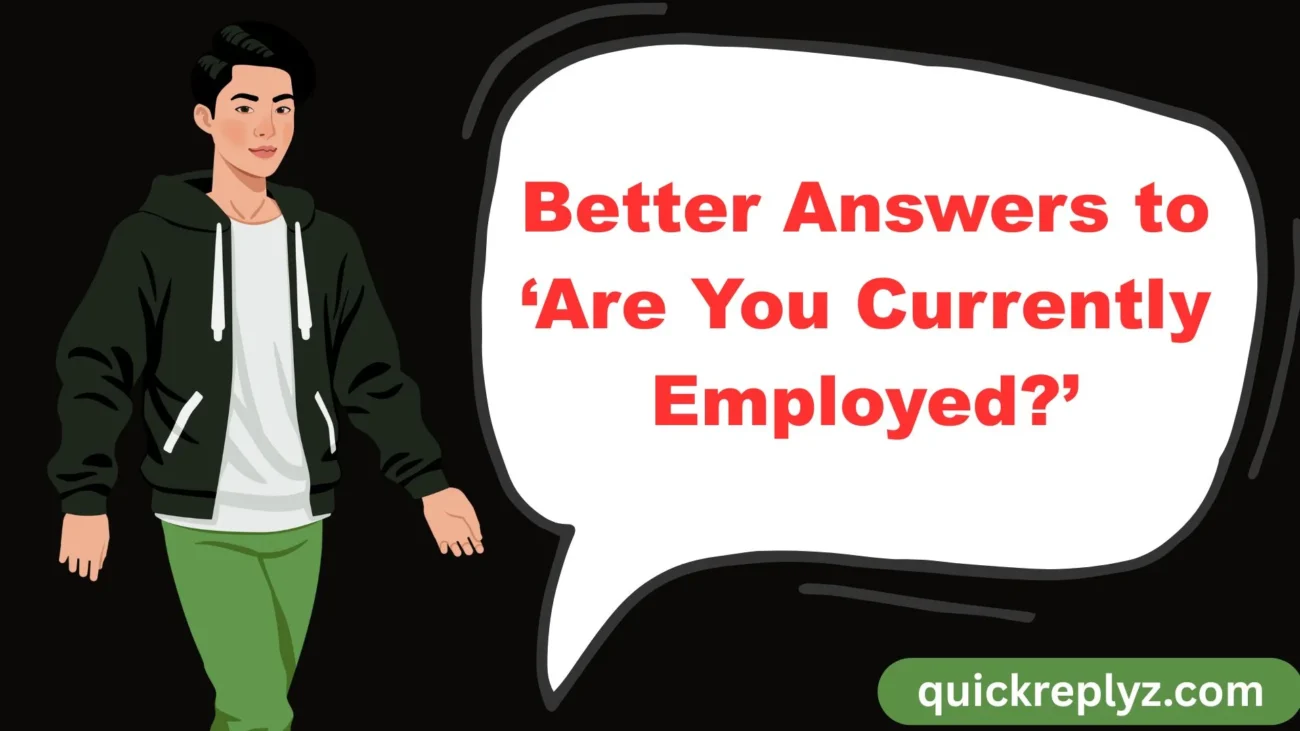When an interviewer asks, “Are you currently employed?”, they’re not just looking for a yes or no. They’re assessing your career status, stability, and professional mindset. Crafting a strong, thoughtful answer can set the tone for the entire interview. In this guide, we’ll explore 30 better answers to ‘Are you currently employed?’—each designed to be authentic, confident, and strategically worded. Whether you’re employed, between jobs, freelancing, or pursuing education, these answers will help you make the best impression possible and position yourself as a valuable candidate.
Another or professional way to say “In Time of Need”
Currently Working and Open to New Opportunities
Employed and Exploring Industry Change
Currently in a Contract Role
Freelancing While Job Searching
Currently Employed and Seeking Leadership Roles
In Transition After Company Restructuring
Taking a Career Break for Skill Development
Working Part-Time While Seeking Full-Time Work
Self-Employed but Ready for Team Collaboration
Employed Remotely and Seeking On-Site Interaction
Currently Employed and Relocating
Volunteering While Seeking Employment
Recently Graduated and Working Interim Jobs
Working in a Different Field While Transitioning
Currently Employed and Seeking Better Work-Life Balance
Currently Working in a Startup and Seeking Stability
On a Sabbatical for Personal Growth
Employed and Looking for Greater Impact
Freelancing Between Full-Time Roles
Currently Employed and Pursuing Advanced Education
Internship Ending Soon
Currently Employed but Seeking Remote Flexibility
Working Multiple Jobs and Seeking Focus
Returning to Work After Parenting Break
Currently in a Seasonal Role
Employed but Seeking International Opportunities
Currently in a Role Below Your Skill Level
Job Sharing and Seeking Full Ownership of a Role
Currently in a Role Misaligned with Career Goals
Between Roles by Choice
1. Currently Working and Open to New Opportunities
If you’re employed but considering a change, show confidence without appearing disloyal. Story: You can explain that you enjoy your current role but are seeking growth and fresh challenges. This shows ambition without criticizing your employer.
Example:
“Yes, I’m currently working as a Marketing Specialist at XYZ Corp, but I’m open to opportunities that allow me to expand my strategic leadership skills.”
Best Use: Use when you want to show loyalty yet readiness for advancement.
2. Employed and Exploring Industry Change
Highlight your current success while showing interest in a new field. Story: This works when you’ve mastered your role but want a career shift into a different industry for personal or professional reasons.
Example:
“I’m currently employed as a Senior Accountant, but I’m eager to apply my analytical skills to the tech industry.”
Best Use: Best for career changers with transferable skills.
3. Currently in a Contract Role
Emphasize flexibility and readiness for a permanent opportunity. Story: Temporary or contract positions often show adaptability and willingness to take on varied challenges.
Example:
“I’m on a six-month contract as a Project Coordinator, and I’m now seeking a full-time role where I can make a long-term impact.”
Best Use: Perfect for transitioning from contract to stable employment.
4. Freelancing While Job Searching
Shows independence and initiative during employment gaps. Story: Freelancing can demonstrate valuable skills like self-management, problem-solving, and client relations.
Example:
“I’ve been freelancing as a graphic designer, which has sharpened my creative skills, and now I’m seeking a collaborative in-house environment.”
Best Use: Ideal when you want to show self-motivation and maintain career momentum.
5. Currently Employed and Seeking Leadership Roles
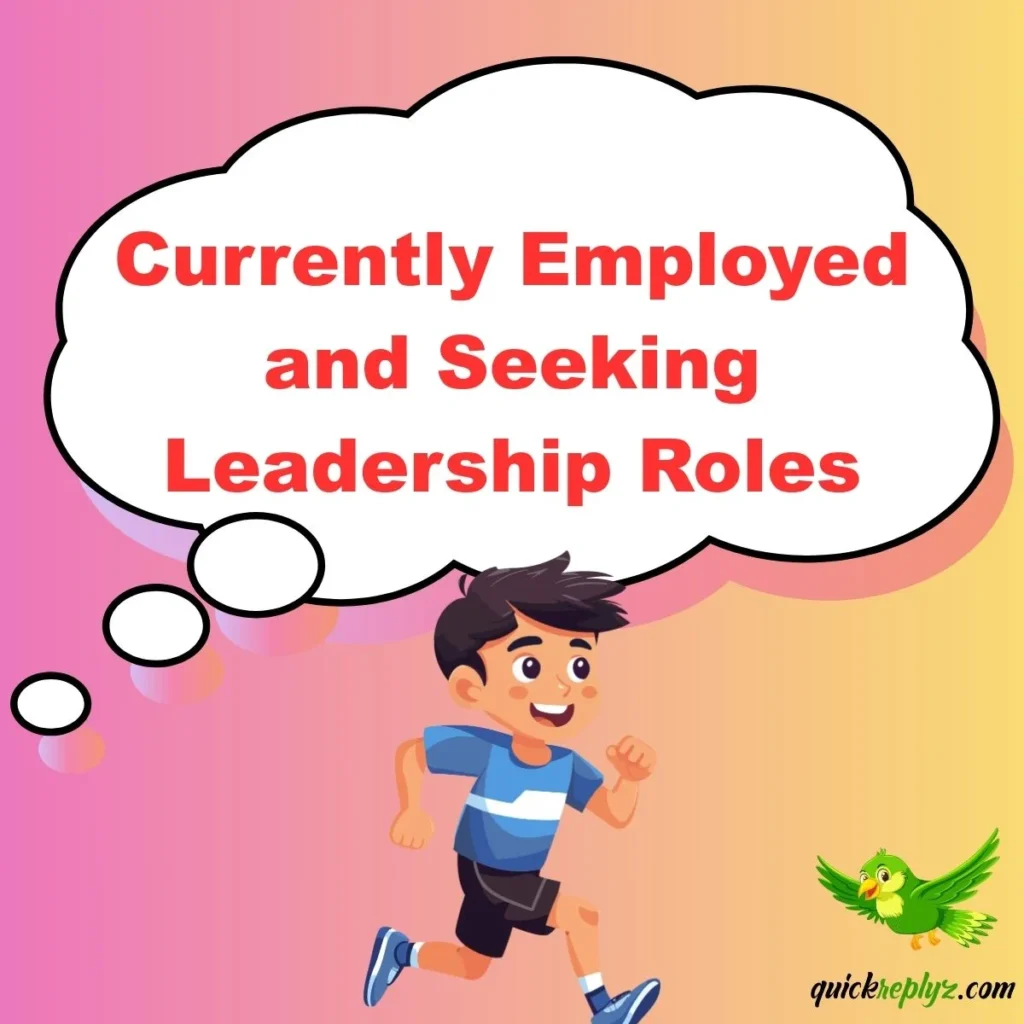
If you’re doing well but want to step up, highlight your leadership ambitions. Story: Employers value candidates who seek greater responsibility while appreciating their current position.
Example:
“I’m currently a Team Lead in customer support, and I’m looking for opportunities to manage larger teams and contribute to organizational strategy.”
Best Use: Ideal for mid-career professionals aiming for management or senior roles.
6. In Transition After Company Restructuring
Show resilience and positivity when explaining a job change. Story: Company closures or downsizing are beyond your control, so focus on your readiness for the next step.
Example:
“My role was affected by company restructuring, and I’m now excited to bring my skills to a growing, dynamic organization.”
Best Use: Best for job seekers wanting to turn a layoff into a positive career move.
7. Taking a Career Break for Skill Development
Show how you’re investing in your future. Story: Taking time to learn new skills demonstrates initiative and adaptability.
Example:
“I took a planned break to complete a certification in data analytics, and I’m eager to apply these new skills in a professional role.”
Best Use: Perfect for career shifters and lifelong learners.
8. Working Part-Time While Seeking Full-Time Work
Displays responsibility and a proactive attitude. Story: Part-time work shows you’re keeping active in the workforce while searching for a better fit.
Example:
“I’m working part-time as a barista while looking for a full-time position in marketing, where I can use my degree and prior experience.”
Best Use: Ideal for graduates or those changing fields.
9. Self-Employed but Ready for Team Collaboration
Shows adaptability from independent work to teamwork. Story: Self-employment can highlight leadership, but you can express a desire for collaborative growth.
Example:
“I run a small web design business, but I miss the dynamic of a creative team and want to contribute to a larger agency.”
Best Use: Great for entrepreneurs moving back into traditional roles.
10. Employed Remotely and Seeking On-Site Interaction
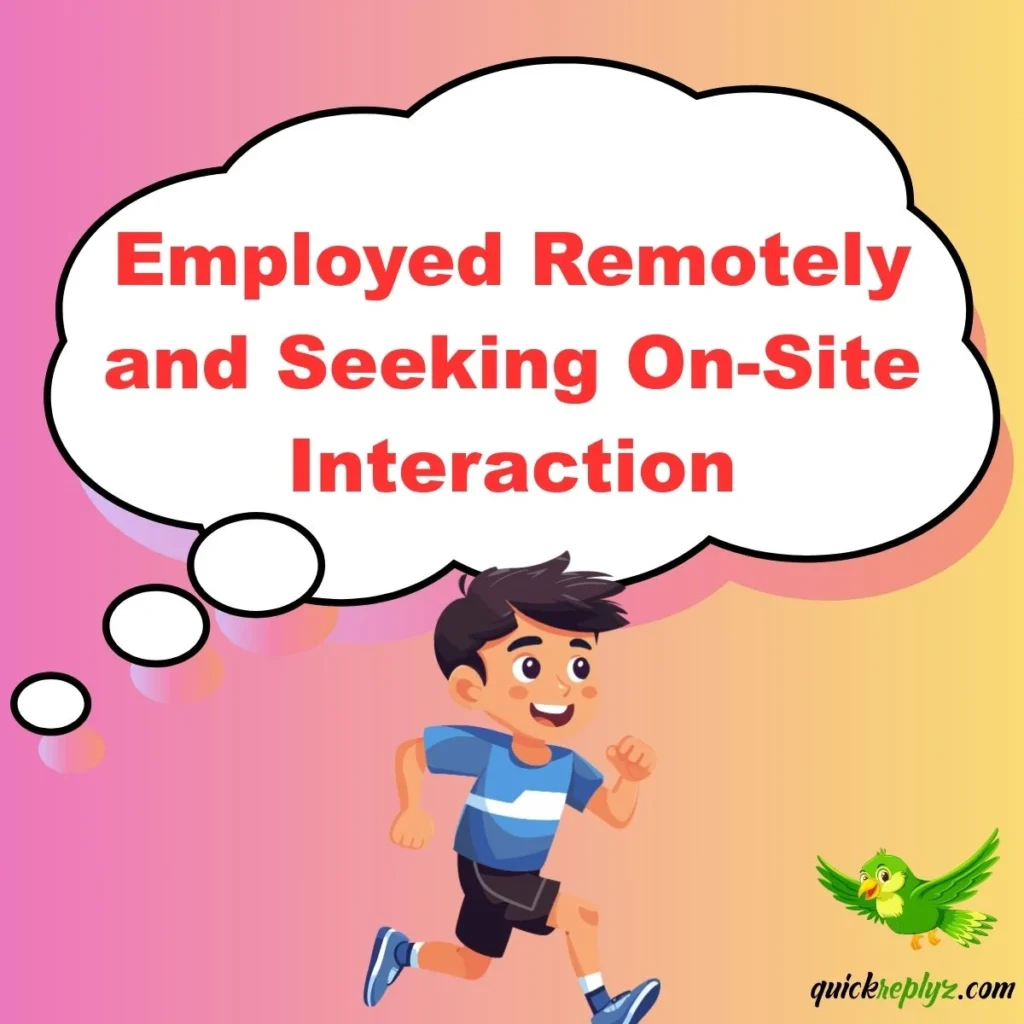
Positions you as adaptable but social. Story: Remote work can be effective, but you might crave in-person collaboration.
Example:
“I currently work remotely as a content writer, but I’m looking for an on-site role where I can engage directly with colleagues.”
Best Use: Perfect for candidates wanting to balance flexibility with personal connection.
11. Currently Employed and Relocating
Explains job search without sounding disengaged. Story: Relocation is a valid reason for seeking new work and shows foresight.
Example:
“I’m working as a sales manager but relocating to New York next month, so I’m seeking opportunities in that area.”
Best Use: Best for location-based career changes.
12. Volunteering While Seeking Employment
Shows initiative and a commitment to giving back. Story: Volunteering keeps your skills sharp and demonstrates community engagement.
Example:
“While between jobs, I’ve been volunteering as a project coordinator for a local charity, which has kept my skills active.”
Best Use: Ideal for job seekers wanting to show productivity during gaps.
13. Recently Graduated and Working Interim Jobs
Highlights your drive after education. Story: Interim roles bridge the gap between academics and career starts.
Example:
“I recently graduated in software engineering and have been working short-term projects while seeking a full-time developer role.”
Best Use: Perfect for new graduates entering the workforce.
14. Working in a Different Field While Transitioning
Positions your experience as versatile. Story: Sometimes, you work outside your primary field while aiming to return.
Example:
“I’m currently working in retail, but my background in logistics makes me eager to return to supply chain management.”
Best Use: Great for professionals returning to their core expertise.
15. Currently Employed and Seeking Better Work-Life Balance
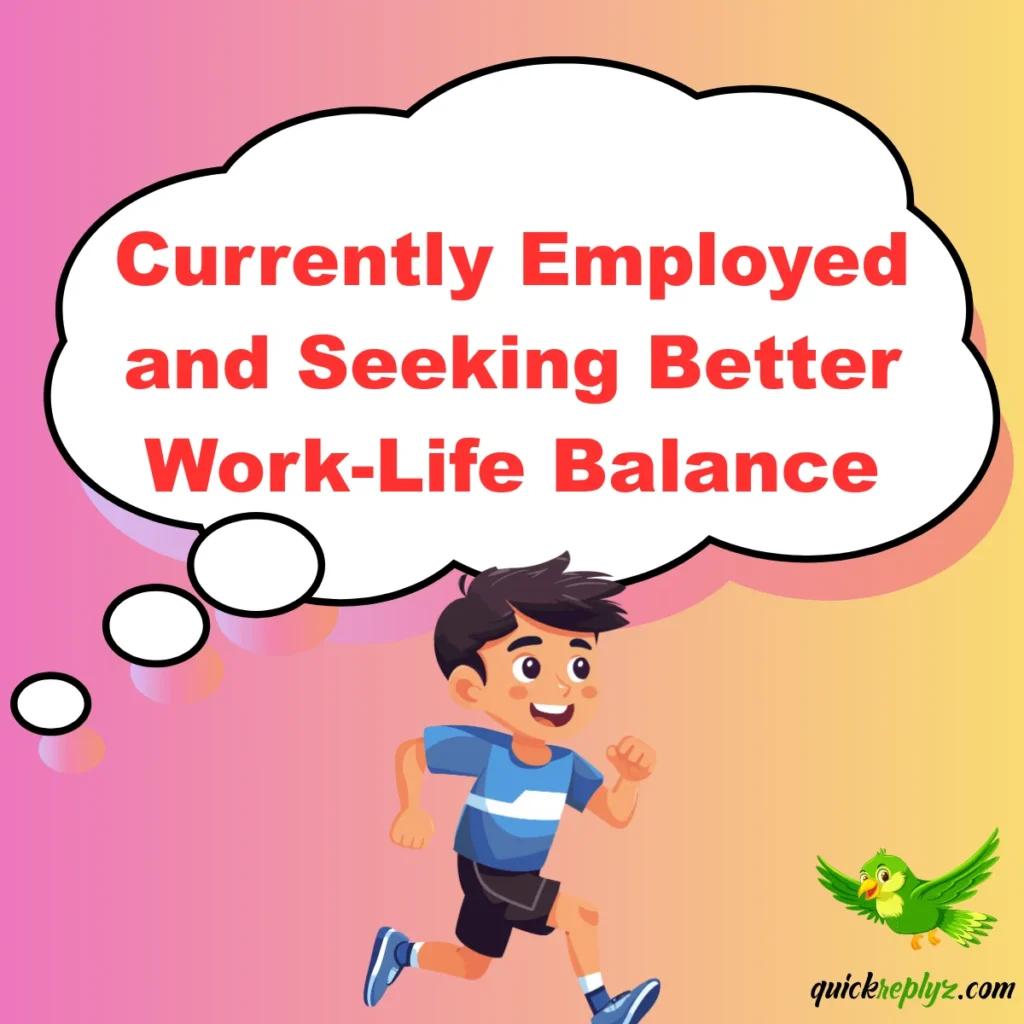
Shows a human side without complaining. Story: Balance is increasingly important in modern work culture.
Example:
“I enjoy my current role in event management, but I’m looking for a position with a more balanced schedule.”
Best Use: Best for professionals wanting to align career with lifestyle.
Also Read This :30 Clever Responses To “What’s The Password?”
16. Currently Working in a Startup and Seeking Stability
Shows ambition but a desire for a solid career foundation. Story: Startups offer growth but can lack stability, making your reasoning relatable.
Example:
“I’m currently a marketing manager at a startup, but I’m seeking a role in a well-established company with long-term growth potential.”
Best Use: Perfect for professionals who value security without diminishing their current role.
17. On a Sabbatical for Personal Growth
Shows you prioritize well-being and long-term productivity. Story: Sabbaticals can help with clarity and skill-building, making you a stronger candidate.
Example:
“I took a six-month sabbatical to travel and broaden my perspectives, and I’m now ready to bring fresh energy to my career.”
Best Use: Best for professionals returning after a planned break.
18. Employed and Looking for Greater Impact
Highlights your desire to contribute more meaningfully. Story: Employers appreciate candidates who seek roles where they can make a difference.
Example:
“I’m currently an operations analyst, but I’m looking for a position where I can influence strategic decisions.”
Best Use: Ideal for those aiming for roles with broader responsibilities.
19. Freelancing Between Full-Time Roles
Shows you’re staying productive while seeking stability. Story: Freelancing demonstrates initiative and skill adaptability.
Example:
“While between full-time positions, I’ve been freelancing in web development to stay sharp and financially independent.”
Best Use: Perfect for professionals avoiding employment gaps.
20. Currently Employed and Pursuing Advanced Education
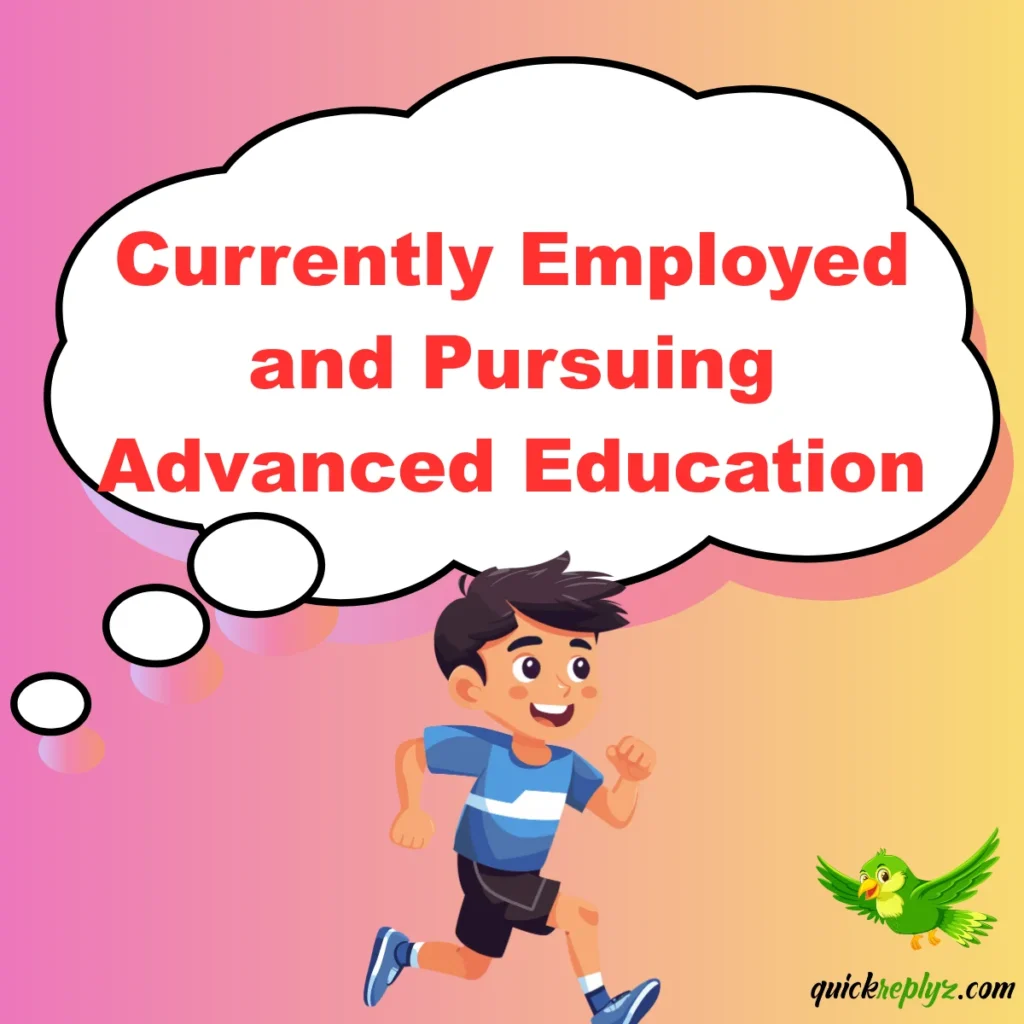
Demonstrates ambition and self-improvement. Story: Balancing work with education shows dedication.
Example:
“I’m working as a business analyst while completing my MBA, and I’m seeking a role aligned with my new expertise.”
Best Use: Ideal for professionals moving into higher-level roles after study.
21. Internship Ending Soon
A positive way to transition into full-time employment. Story: Internships provide skills and experience to leverage in a job search.
Example:
“I’m currently interning as a junior designer, and I’m eager to secure a full-time position where I can continue to grow.”
Best Use: Best for recent graduates or those entering a new field.
22. Currently Employed but Seeking Remote Flexibility
Shows adaptability and forward-thinking. Story: Remote options can support productivity and work-life balance.
Example:
“I enjoy my current role, but I’m looking for a remote position to better manage my family commitments.”
Best Use: Ideal for candidates prioritizing flexibility.
23. Working Multiple Jobs and Seeking Focus
Shows dedication but a desire for stability. Story: Managing multiple jobs proves time management skills.
Example:
“I’m currently juggling two part-time roles, but I’m seeking one full-time position where I can fully focus my efforts.”
Best Use: Perfect for those wanting to consolidate their workload.
24. Returning to Work After Parenting Break
Positions personal choices positively. Story: Parenting breaks show commitment and can develop transferable skills.
Example:
“I took a break to raise my children, and I’m now ready to re-enter the workforce with renewed energy.”
Best Use: Great for parents rejoining the job market.
25. Currently in a Seasonal Role
Shows adaptability to temporary work. Story: Seasonal roles help keep skills active while seeking permanence.
Example:
“I’m currently working a seasonal retail job, but I’m seeking a long-term career in supply chain operations.”
Best Use: Best for transitioning from temporary to permanent work.
26. Employed but Seeking International Opportunities
Highlights global ambition. Story: International roles can enhance cultural and professional growth.
Example:
“I’m working in IT here in Pakistan, but I’m looking for opportunities abroad to expand my global experience.”
Best Use: Ideal for professionals seeking cross-border exposure.
27. Currently in a Role Below Your Skill Level
Shows ambition without sounding arrogant. Story: Sometimes, you take a role for practical reasons but want to grow.
Example:
“I’m currently in a junior analyst role, but my background equips me for a senior-level challenge.”
Best Use: Perfect for candidates aiming for advancement.
28. Job Sharing and Seeking Full Ownership of a Role
Shows commitment and readiness for responsibility. Story: Job sharing develops collaboration skills but may limit full engagement.
Example:
“I share a project management role, but I’m looking for a position where I can take full ownership of outcomes.”
Best Use: Great for those ready for full accountability.
29. Currently in a Role Misaligned with Career Goals
Reframes dissatisfaction into ambition. Story: Misalignment can be presented as a motivator for change.
Example:
“I’m currently working in admin, but my passion lies in event planning, which I’m eager to pursue.”
Best Use: Best for career changers highlighting passion.
30. Between Roles by Choice
Shows intentionality in your career moves. Story: Taking time between jobs can be strategic for finding the right fit.
Example:
“I recently left my role to carefully evaluate my next career step and find a position aligned with my strengths.”
Best Use: Ideal for professionals prioritizing the right opportunity over speed.
Conclusion
Answering “Are you currently employed?” is more than stating your job status—it’s an opportunity to shape the interviewer’s perception. Whether you’re employed, freelancing, between jobs, or returning after a break, the key is to present your situation positively, strategically, and confidently. Use these 30 better answers to position yourself as the best choice for any role.
FAQs
Q1: How honest should I be when answering “Are you currently employed?” Always be truthful, but focus on the positive aspects and your future goals.
Q2: Should I mention unemployment in an interview? Yes, but frame it in a way that highlights productivity, such as upskilling or volunteering.
Q3: Can I say I’m employed if I’m freelancing? Yes, freelancing counts as employment—just be clear about the nature of the work.
Q4: How long should my answer be? Keep it concise—one to two sentences is ideal, with a positive and forward-looking tone.
Q5: What if my reason for leaving a job is negative? Avoid negativity; instead, focus on what you’re looking for in your next role.

